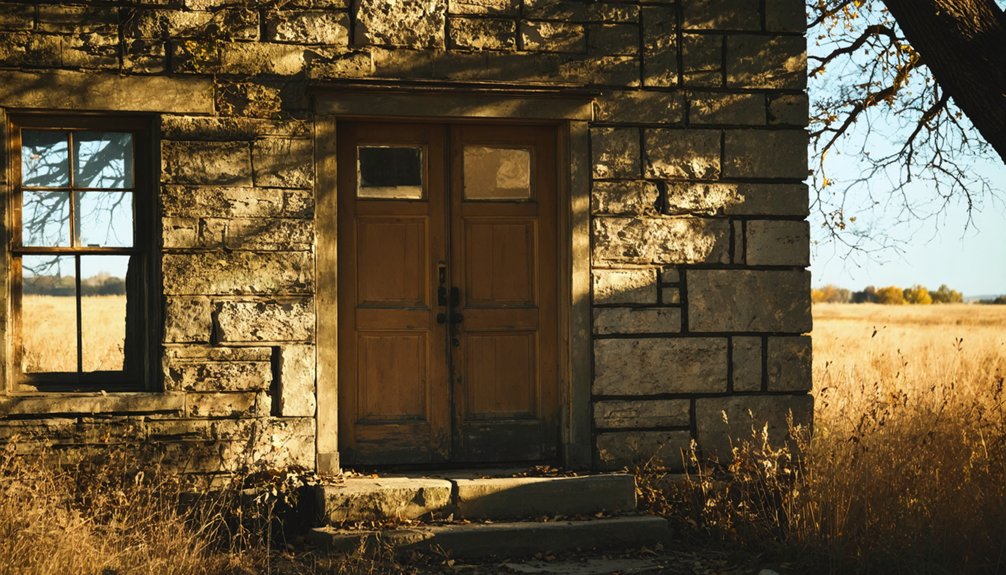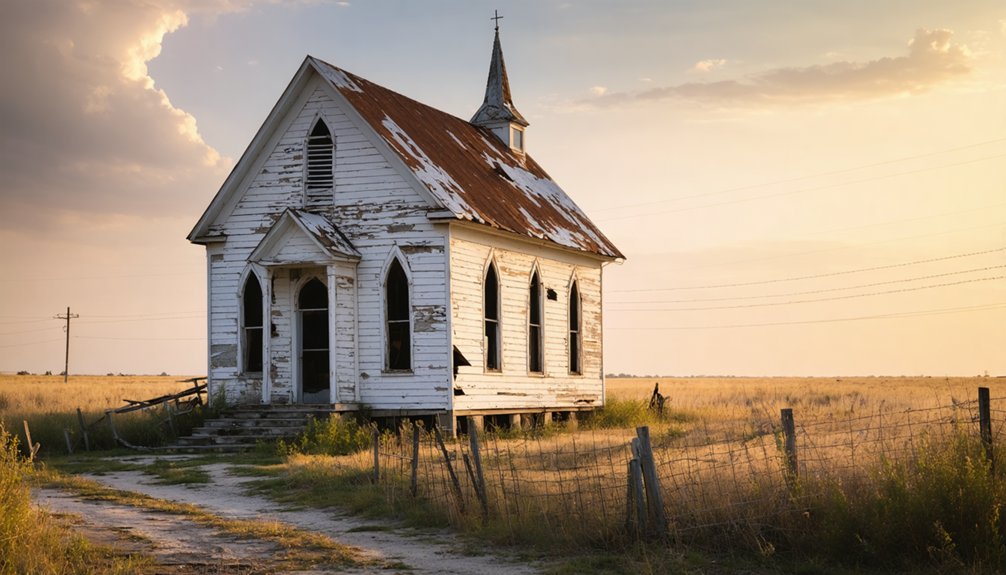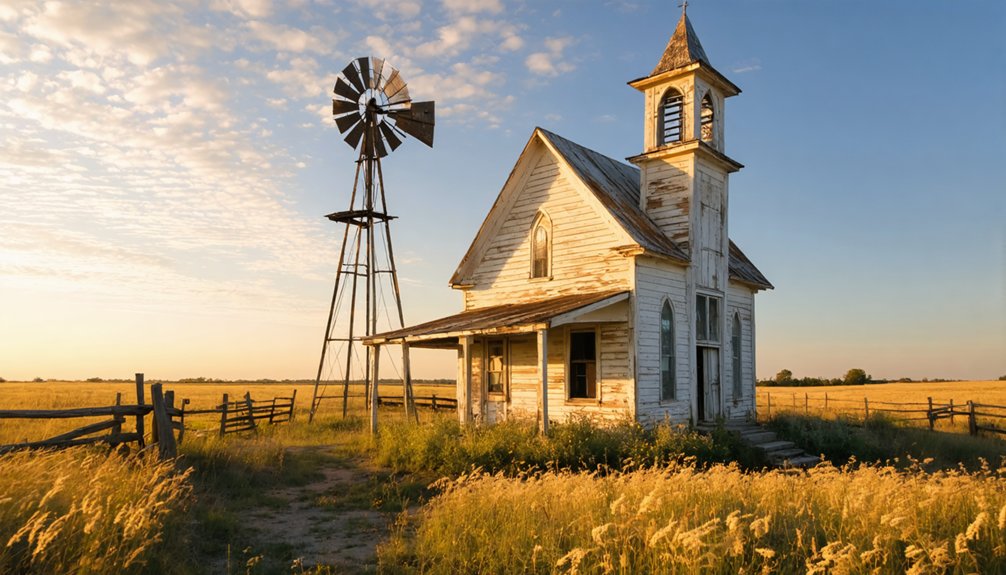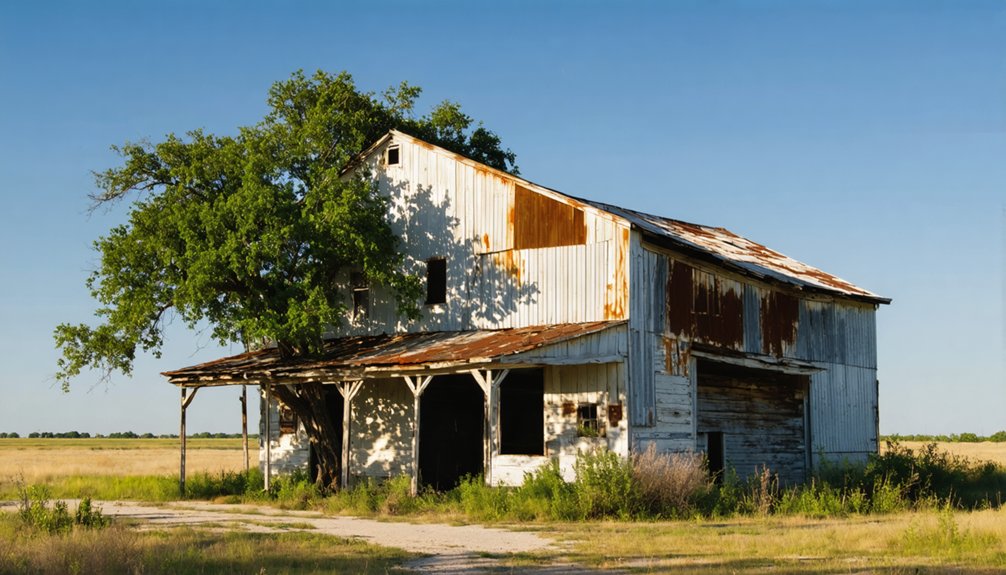You’ll discover the ghostly remnants of Duffau in Erath County, Texas, where a vibrant frontier community once thrived. Named after Czechoslovakian settlers and an Indigenous person called “Duffo,” the town peaked at 350 residents in the mid-1880s, boasting three mercantile stores, a cotton gin, and various mills. When the railroad bypassed Duffau, its fate was sealed. Today, the crumbling rock schoolhouse, gymnasium, and Baptist church whisper tales of its prosperous past.
Key Takeaways
- Duffau transformed from a thriving 350-person frontier community into a ghost town after being bypassed by the Gulf, Colorado & Santa Fe Railroad.
- The town’s remaining structures include a rock schoolhouse, gymnasium, and Baptist church, serving as historical landmarks of its past prosperity.
- Population declined sharply from 350 in the 1880s to 110 by 1940 as younger residents left for urban opportunities.
- The cemetery, established in 1874 with over 950 marked graves, stands as a testament to the once-vibrant community.
- Duffau’s abandoned buildings and foundations provide insights into 19th-century Texas frontier life and early settlement patterns.
The Origins of Duffau’s Name
While many Texas towns bear names reflecting Anglo-American or Spanish heritage, Duffau stands apart as a tribute to the Czechoslovakian immigrants who settled there.
In the late 19th century, these pioneering families brought their cultural heritage to Erath County, choosing to name their new settlement after a Slovak or Czech surname that connected them to their homeland.
You’ll find this immigrant influence woven into the very identity of Duffau, as the settlers deliberately preserved their Eastern European roots through the town’s distinctive name.
Though the spelling and pronunciation may have evolved from its Slavic origins, Duffau’s name remains a powerful representation of the determination of these early settlers to maintain their cultural identity in the vast Texas frontier.
Like the town of Catarina which experienced a significant population decline by 1931, this once-thriving community now stands as a testament to the changing landscape of rural America.
Located in Erath County, Texas, this once-thriving community now stands as a testament to the changing landscape of rural America.
A Flourishing Texas Frontier Town
You’ll find Duffau’s early prosperity reflected in its bustling agricultural economy of the 1860s, where frontier farmers established productive homesteads near the life-giving Nolands River.
The town’s golden age brought a vibrant mix of general stores, blacksmiths, and farming suppliers, serving the needs of a growing population of frontier families. The area saw major changes when cotton farming dominated from 1875 onward, transforming the local agricultural landscape.
Local health tourism flourished when visitors flocked to the area’s mineral wells resort, seeking therapeutic treatments and relaxation.
Early Economic Growth
During the late 1850s, Duffau blossomed into a vibrant frontier trade center, built on the sturdy foundation of agricultural commerce and enhanced by its therapeutic mineral wells.
You’d have found farmers bringing their crops to market, establishing a pattern of agricultural sustainability that defined the community’s economic resilience. Just as Thurber’s miners were paid with company store scrip, Duffau’s early farmers often relied on a local barter system for their goods.
The town’s strategic position made it a natural hub where you could trade goods, attend one of several churches, or seek healing at the renowned mineral wells.
Peak Population Period
As Duffau reached its peak population in the late 19th century, nearly 150 residents called this frontier settlement home.
You’d have found a bustling community of hardy settlers, mostly of European descent, who’d carved out their piece of Texas freedom through farming and ranching. The population dynamics reflected the era’s frontier spirit, with large families working together to tame the land and build a future. Like many rural Texas towns today facing population loss, young residents gradually moved away seeking better opportunities.
The community’s resilience showed through its:
- Tight-knit social fabric centered around the local schoolhouse and community gatherings
- Self-sufficient households managing their own water supply through wells and springs
- Strong cooperative ethic during harvests and livestock management
These pioneers created a sustainable rural society, though their numbers would later dwindle as the 20th century’s economic changes drew younger generations to urban opportunities. Much like other frontier settlements, Duffau managed to avoid the violent lawlessness that plagued oil boom towns such as Best, Texas.
Early Settlement and Post Office
The origins of Duffau can be traced to a remarkable Indigenous person known as “Duffo,” whose burial site near the settlement inspired its name.
You’ll find this pre-1860 frontier community nestled in Erath County’s rolling Hill Country, where early settlers carved out homesteads from the rugged Texas landscape.
The establishment of Duffau’s post office in 1860 marked a significant moment in the settlement’s development. Much like Cannonville’s post office in 1857, it represented a milestone in the town’s growth.
You’d have found this essential hub serving as more than just a mail stop – it was the thread that wove the community together, connecting isolated farmsteads to the wider world.
The post office’s presence signaled permanence and drew more settlers to the area, helping transform Duffau from a scattered collection of homesteads into a proper settlement by the mid-1880s.
Peak Years of Growth and Commerce
You’d find Duffau’s peak years marked by scattered farmsteads and ranches surrounding a modest business district, where locals gathered to trade goods and share news at the general store.
The community’s social fabric wove tightly around its churches and school, creating bonds that sustained families through both prosperous harvests and lean times. Like many Texas settlements, Duffau’s fate was tied to economic fluctuations that shaped rural communities across the state.
Though never growing into a large town, Duffau’s commercial heart supported several essential businesses like blacksmith shops and mercantile establishments that served the rural population’s daily needs.
Population Growth Patterns
During Duffau’s prime years between 1900 and 1930, this small Texas farming community experienced modest but steady population growth typical of rural Erath County settlements. The demographic shifts followed agricultural trends, with families drawn to the promise of fertile soil and open spaces where you’d find a close-knit farming community taking root. Like many similar towns that later faced difficulties, Duffau would eventually see population decline continue, mirroring the regional pattern seen across rural Texas.
- Local commerce thrived with general stores and farm suppliers serving the growing population.
- Agricultural prosperity drove steady population increases until the 1950s.
- Families settled permanently, establishing schools and community gathering places.
But you couldn’t find railroad access or major highways in Duffau like its neighboring towns, which ultimately limited its growth potential.
When modernization swept through Texas in the mid-1900s, the town’s isolation became its greatest challenge, leading to a gradual decline that transformed this once-bustling community into a ghost town.
Thriving Business District
Alongside Duffau’s steady population growth came a vibrant business district that buzzed with commercial activity from 1885 through the early 1900s.
You’d find a robust hub of local commerce centered around three mercantile stores, a cotton gin, and essential mills for processing timber and grain. The town’s business resilience showed in its diverse offerings – from Henry L. Reeves’ trading post to a specialized millinery shop where you could purchase the latest hat styles.
The 1883 post office establishment strengthened Duffau’s position as a crucial trade center, while Dr. Rowbarts’ office brought professional services to the community.
This prosperous run came to an abrupt halt in 1893 when a devastating fire, sparked by black powder, destroyed all but two buildings in the business district.
Religious and Social Life
As faith anchored daily life in Duffau’s peak years, four churches stood as pillars of the community by the mid-1880s, with the Baptist church’s rock building remaining among today’s visible ruins.
You’d find church gatherings at the heart of social bonds, where families joined for Sunday services, weddings, and community events that defined small-town Texas living.
- Three local doctors provided healthcare while two deputy sheriffs maintained order
- The rock schoolhouse and gym hosted educational and social functions
- Community dances, harvest festivals, and church socials brought neighbors together
Life revolved around these cherished institutions, where multi-generational households gathered regularly.
The churches, schools, and meeting places fostered a tight-knit community spirit, with seasonal celebrations and religious holidays marking the rhythm of Duffau’s vibrant social calendar.
The Impact of Railroad Decisions
The fate of Duffau, Texas hinged on crucial railroad decisions that would ultimately seal its destiny as a ghost town. When the Gulf, Colorado & Santa Fe Railroad chose to bypass this once-promising settlement, you could feel the town’s heartbeat begin to fade.
The railroad’s influence extended far beyond mere transportation – it determined which communities would thrive and which would wither away into obscurity.
Duffau’s economic isolation became inevitable as nearby towns, blessed with rail connections, drew away trade, settlers, and opportunities. You’d have watched helplessly as businesses relocated closer to the tracks, followed by families seeking better prospects.
Without rail access, local farmers couldn’t compete in broader markets, and the town’s commercial significance slowly drained away, leaving behind empty buildings and quiet streets.
Preserved Historical Structures

While many Texas ghost towns have lost all traces of their past, Duffau’s remaining structures tell a compelling story of its former liveliness.
You’ll find remarkable architectural styles preserved in the old schoolhouse, rock gymnasium, and Baptist church, each crafted from local stone in true 19th-century fashion. These buildings stand as silent witnesses to Duffau’s historical significance as a thriving community.
- The Baptist church remains intact, representing one of four religious congregations that once served the town.
- Educational facilities, including the preserved schoolhouse and gymnasium, showcase the town’s commitment to learning.
- The cemetery, established in 1874, contains over 950 marked graves including Civil War and World War veterans.
These enduring structures aren’t just ruins – they’re tangible connections to Duffau’s vibrant past, each telling its own story of community life.
Life in 19th Century Duffau
During its peak in the 1880s, life in Duffau bustled with activity as 350 residents forged a self-sustaining community centered around agriculture and local commerce.
You’d find steam-powered mills humming while cotton gins processed the region’s harvest. Three doctors tended to residents’ health needs, while two deputy sheriffs maintained law and order.
Community gatherings flourished at the four churches and district school, where you’d join your neighbors for social events and worship. Local trades thrived, with a hotel serving travelers and merchants providing essential goods.
You’d witness daily routines of farming, milling, and commerce, all woven together by the strong social fabric that characterized this rural Texas town. Life maintained its vibrant pace until railroads bypassed Duffau in the 1890s.
The Gradual Decline

You’ll find the key turning point in Duffau’s decline came when railroad companies chose to bypass the town in the late 19th century, effectively cutting off its economic lifeline.
The town’s population, which had peaked at around 350 in the mid-1880s, steadily dwindled as residents sought opportunities in better-connected communities, leaving only 110 souls by 1940.
You can trace the exodus pattern through shuttered businesses and abandoned buildings, as younger generations left their family farms behind, drawn to the promise of urban prosperity and modern conveniences that Duffau couldn’t provide.
Railroad’s Fatal Impact
As the railroad lines of the late 19th century strategically bypassed Duffau, they sealed the town’s fate with devastating precision.
Those railroad decisions left the once-promising settlement in economic isolation, cutting it off from the crucial commercial arteries that would’ve sustained its growth.
You can trace Duffau’s decline through the stark reality of missed opportunities:
- Major rail routes chose larger neighboring towns, shifting commerce away
- Agricultural products couldn’t reach broader markets without freight connections
- Businesses and residents gradually relocated to rail-connected communities
What you’re seeing in Duffau’s story is a pattern repeated across Texas – when the railroads bypassed a town, they fundamentally wrote its obituary.
Without access to the expanding rail network, Duffau couldn’t compete with surrounding communities that flourished along the iron rails.
Population Exodus Patterns
While the railroad’s absence initially wounded Duffau, the town’s true population decline didn’t accelerate until the 1950s, following a pattern seen across northwest Texas.
You’d have witnessed population trends that mirrored many small towns in the region, as younger generations sought opportunities in bigger cities. The steady youth migration left behind an aging community struggling to maintain its identity.
Like countless rural settlements, Duffau watched its importance drain away as essential services disappeared one by one.
You would have seen the school close, followed by local businesses, creating a domino effect that pushed more residents to leave.
Notable Buildings and Landmarks Today
The stone remnants of Duffau’s past stand as silent sentinels along Farm Road 1824, with several historically significant structures still gracing the landscape.
You’ll find the old schoolhouse and its adjacent rock gymnasium showcasing the ghostly architecture that once served local students. The Baptist church‘s sturdy stone walls continue to reflect the town’s spiritual heritage, while scattered ruins of cotton gins and flour mills hint at Duffau’s prosperous agricultural days.
- The historic cemetery, marked with interpretive signs, tells the story of early settlers and the town’s namesake Indian.
- Stone construction methods unique to Duffau set it apart from typical wooden structures in other Texas ghost towns.
- The community center remains as one of the few gathering places still maintained, preserving local connections.
Legacy of a Lost Community

Standing amid Duffau’s weathered stones, you’ll discover a poignant tribute to rural Texas life that transcends mere physical remnants. The town’s story exemplifies remarkable community resilience, from its vibrant beginnings as a hub of commerce and culture to its gradual transformation into a ghost town.
Though the population has dwindled to mere dozens, Duffau’s legacy lives on through historical preservation efforts at sites like the cemetery and church ruins.
You’ll find echoes of the past in every crumbling foundation – reminders of the four churches, steam mills, and bustling streets that once defined this settlement.
While the railroad’s bypass sealed Duffau’s fate, the remaining structures and stories paint a vivid portrait of 19th-century Texas life, preserving essential lessons about adaptation and survival in the American West.
Frequently Asked Questions
Are There Any Annual Events or Gatherings Still Held in Duffau?
You won’t find regular ghost tours or local festivals happening there anymore. While other Texas ghost towns host annual gatherings, Duffau’s minimal population and limited infrastructure don’t support organized events today.
What Native American Tribes Originally Inhabited the Duffau Area?
While fierce Comanches dominated the region’s cultural heritage in the 1700s, you’ll find that Tonkawa and Lipan Apache tribes originally called this area home, leaving traces of their tribal history behind.
How Dangerous Was Frontier Life in Early Duffau?
You’d face constant frontier hardships in early settlement – from hostile Native American raids to devastating fires, harsh farming conditions, and deadly diseases, with survival strategies centered on self-reliance and community defense.
Did Any Famous Outlaws or Historical Figures Ever Visit Duffau?
You won’t find records of Billy the Kid, Jesse James, or other notorious outlaws visiting. Unlike many frontier towns that attracted infamous characters, Duffau remained a quiet farming community without documented outlaw connections.
What Natural Disasters Have Impacted Duffau Throughout Its History?
You won’t find many documented natural disasters in Duffau’s history, though the area experienced regional drought effects typical of Central Texas. No specific flood impacts or major catastrophes are recorded in historical accounts.
References
- https://en.wikipedia.org/wiki/Duffau
- https://www.ghosttowns.com/states/tx/duffau.html
- https://kids.kiddle.co/Duffau
- https://www.davickservices.com/duffau_school_1915.htm
- https://en.wikipedia.org/wiki/List_of_ghost_towns_in_Texas
- https://freepages.history.rootsweb.com/~gtusa/usa/tx.htm
- https://www.texasescapes.com/CentralTexasTownsNorth/DuffauTexas.htm
- https://www.youtube.com/watch?v=BoQlQniHRNU
- https://jamesbigleyranches.com/general/texas-ghost-towns/
- https://kicks105.com/ghost-town-strange-name/



